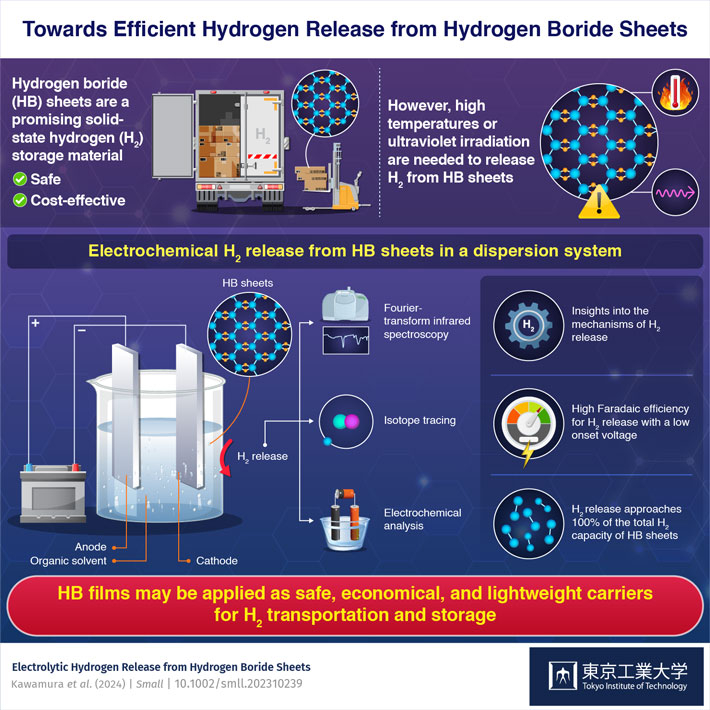Hydrogen stored in hydrogen boride sheets can be efficiently released electrochemically, report scientists at Tokyo Tech, Osaka Univ., and Univ. Tsukuba. Through a series of experiments, they demonstrated that dispersing these sheets in an organic solvent and applying a small voltage is enough to release all the stored hydrogen efficiently. These findings suggest hydrogen boride sheets could soon become a safe and convenient way to store and transport hydrogen, which is a cleaner and more sustainable fuel.

The looming threat of climate change has motivated scientists worldwide to look for cleaner alternatives to fossil fuels, and many believe hydrogen is our best bet. As an environmentally friendly energy resource, hydrogen (H2) can be used in vehicles and electric power plants without releasing carbon dioxide into the atmosphere.
However, storing and transporting H2 safely and efficiently remains a challenge. Compressed gaseous hydrogen poses a significant risk of explosion and leakage, whereas liquid hydrogen must be maintained at extremely low temperatures, which is costly. But what if we could store hydrogen directly in the molecular composition of other liquid or solid materials?
This was the focus of a team of scientists from Japan, who, in a recent study published in the journal Small, investigated the potential of hydrogen boride (HB) sheets as practical hydrogen carriers. Storing hydrogen in HB sheets is not an entirely new concept, and many aspects of their potential applications as hydrogen carriers have already been studied. However, getting the hydrogen out of the sheets is the tricky part. Heating at high temperatures or strong ultraviolet (UV) illumination is required to release hydrogen (H2) from HB sheets. However, both approaches have inherent disadvantages, such as high energy consumption or incomplete H2 release.
Thus, the team delved into a potential alternative: electrochemical release. Based on the mechanism of UV-induced H2 release from HB sheets, the team speculated that electron injection from a cathode electrode into HB nanosheets by an electric power supply could be a superior way to release H2 compared to UV irradiation or heating.
Based on this theory, the researchers dispersed HB sheets into acetonitrile-an organic solvent-and applied a controlled voltage to the dispersion. These experiments revealed that nearly all of the electrons injected into the electrochemical system were used to convert H+ ions from the HB sheets into H2 molecules. Notably, the Faradaic efficiency of this process, which measures how much electrical energy is converted into chemical energy, was over 90%.
The team also conducted isotope tracing experiments to confirm that the electrochemically released H2 originated from the HB sheets and not through some other chemical reaction. Moreover, they also employed scanning electron microscopy and X-ray photoelectron spectroscopy to characterize the sheets before and after H2 release, yielding further insights into the underlying mechanisms of the process.
These findings contribute to the development of safe and lightweight hydrogen carriers with low energy consumption. Although the team studied the dispersed form of the HB sheets in the published paper, the current findings are applicable to film or bulk-based HB sheet systems for H2 release. Moreover, the team will investigate the rechargeability of HB sheets after dehydrogenation in a future study.
With any luck, this line of research will help pave the way to cleaner energy sources and more sustainable societies!
Reference
Authors : | Satoshi Kawamura1, Akira Yamaguchi1,*, Keisuke Miyazaki1, Shin-ichi Ito2, Norinobu Watanabe3, Ikutaro Hamada4, Takahiro Kondo2,5,6,*, and Masahiro Miyauchi1,* |
Title : | Electrolytic Hydrogen Release from Hydrogen Boride Sheets |
Journal : | Small |
DOI : | |
Affiliations : | 1 Department of Materials Science and Engineering, School of Materials and Chemical Technology, Tokyo Institute of Technology, Meguro-ku, Tokyo, 152-8552, Japan 2 Department of Materials Science, Institute of Pure and Applied Sciences, University of Tsukuba, Tsukuba, 305‐8573, Japan 3 Graduate school of Science and Technology, University of Tsukuba, Tsukuba, 305‐8573, Japan 4 Department of Precision Engineering, Graduate School of Engineering, Osaka University, Suita, Osaka, 565-0871, Japan 5 The Advanced Institute for Materials Research, Tohoku University, Sendai, Miyagi, 980-8577, Japan 6 Tsukuba Research Center for Energy Materials Science, Institute of Pure and Applied Sciences and R&D Center for Zero CO2 Emission Functional Materials, University of Tsukuba, Tsukuba, 305-8573, Japan |








